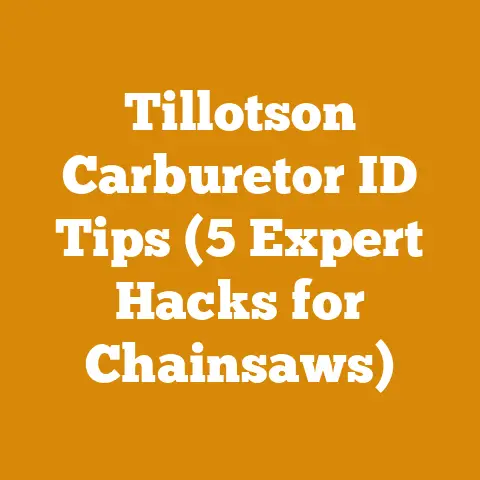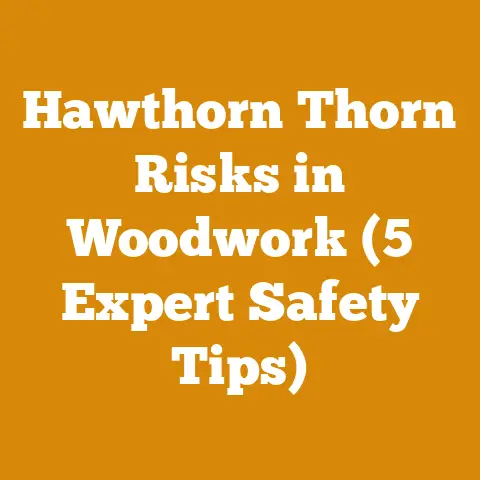Large Poison Ivy Vine Removal (5 Proven Arborist Techniques)
Introduction: Leveling Up My Poison Ivy Vine Removal Game
Alright, let’s talk poison ivy. Not just the little ground-hugging stuff, but the monstrous, tree-climbing vines that look like they could star in a horror movie. I’ve tangled with my fair share of these over the years, and let me tell you, it’s a battle I’ve learned to respect. I’ve seen homeowners try everything from boiling water to gasoline (don’t do that, please!) with limited success and a whole lot of frustration.
The user intent is to learn safe and effective methods for removing large poison ivy vines, likely clinging to trees, focusing on techniques used by professional arborists. This includes understanding the tools, safety precautions, and step-by-step processes involved.
This guide isn’t about quick fixes; it’s about providing proven, arborist-level techniques that tackle the problem at its source, minimizing the risk of regrowth and, most importantly, protecting you from that nasty urushiol oil. I’m going to share the methods I’ve honed over years of dealing with these botanical bullies, ensuring you can reclaim your property without the itchy aftermath.
Large Poison Ivy Vine Removal: 5 Proven Arborist Techniques
Understanding the Enemy: Identifying Large Poison Ivy Vines
Before you even think about grabbing a tool, you need to be 100% sure you’re dealing with poison ivy. Misidentification can lead to wasted effort and, worse, contact with something even more irritating.
- Leaf Identification: The classic “leaves of three, let it be” rhyme is your first line of defense. Poison ivy leaves grow in clusters of three leaflets. The middle leaflet has a longer stalk than the two side leaflets. The leaves can vary in shape, from smooth to slightly toothed, and the color can range from bright green in the spring to reddish-orange in the fall.
- Vine Characteristics: Large poison ivy vines can be incredibly thick, sometimes reaching several inches in diameter. They often have a hairy or rope-like appearance and can cling tightly to tree bark. One key identifier is the presence of aerial roots – small, hair-like roots that grow out from the vine and attach to the tree.
- Distinguishing from Look-Alikes: Virginia creeper is a common culprit for mistaken identity. It has five leaflets, not three. Boxelder seedlings also have three leaflets, but they are arranged oppositely on the stem, unlike poison ivy’s alternating arrangement.
- Seasonal Variations: In the fall, poison ivy leaves turn vibrant shades of red and orange, making them easier to spot. In the winter, the bare vines can still be identified by their hairy appearance and aerial roots.
- Urushiol Oil: Remember, even dead poison ivy vines contain urushiol oil, the substance that causes the allergic reaction. Handle all parts of the plant with extreme caution, regardless of the season.
My Experience: I once misidentified a young poison ivy plant as a harmless ground cover. A week later, I was covered in an itchy rash from head to toe. Lesson learned: always double-check!
Takeaway: Accurate identification is crucial for effective and safe poison ivy removal. When in doubt, consult a local arborist or extension service for confirmation.
Safety First: Gear Up for Battle
Poison ivy removal is not a task to be taken lightly. Urushiol oil is incredibly potent, and even a tiny amount can cause a severe allergic reaction. Proper protective gear is essential.
- Full-Body Coverage: Wear long sleeves, long pants, and a hat to minimize exposed skin. Tuck your pants into your boots to prevent vines from sneaking in.
- Gloves: Use heavy-duty, chemical-resistant gloves, such as nitrile or vinyl. Avoid latex gloves, as urushiol can penetrate them. I prefer extended cuff gloves that go up to my elbows for maximum protection.
- Eye Protection: Safety glasses or goggles are a must to protect your eyes from sap and debris.
- Respirator (Optional but Recommended): If you’re sensitive to poison ivy or are dealing with a large infestation, consider wearing a respirator to avoid inhaling urushiol particles. A NIOSH-approved N95 respirator will provide adequate protection.
- Clothing Disposal/Cleaning: After removing poison ivy, carefully remove your clothing, avoiding contact with the outer surfaces. Wash your clothes immediately in hot water with a strong detergent. Some people prefer to dispose of the clothes altogether to avoid any risk of contamination.
- Skin Cleansing: Wash your exposed skin thoroughly with soap and water as soon as possible. Special poison ivy washes, containing ingredients like Tecnu or Zanfel, are designed to remove urushiol oil and can be very effective if used promptly.
- Tool Cleaning: Clean your tools with rubbing alcohol or a specialized poison ivy cleaner to remove any urushiol residue.
My Experience: I once skipped wearing gloves for a “quick” poison ivy removal and paid the price with a miserable rash that lasted for weeks. Now, I suit up like I’m going into a hazmat zone.
Data: Studies show that washing with soap and water within 10 minutes of exposure can remove up to 50% of urushiol oil.
Takeaway: Protective gear is your best defense against poison ivy. Don’t cut corners on safety.
Technique 1: The Cut-and-Treat Method (Arborist’s Go-To)
This is my preferred method for tackling large poison ivy vines, especially those climbing trees. It’s effective, minimizes the risk of spreading the plant, and allows you to target the root system directly.
- Step 1: Cutting the Vine: Using loppers or a pruning saw, cut the vine near the base of the tree, as close to the ground as possible. Make a second cut about 6-12 inches above the first cut. This creates a section of vine that you can remove without disturbing the rest of the plant.
- Step 2: Removing the Section: Carefully remove the cut section of vine, being mindful not to touch it with your bare skin. Dispose of it properly in a sealed bag.
- Step 3: Applying Herbicide: Immediately apply a systemic herbicide containing glyphosate or triclopyr to the freshly cut stump. Use a paintbrush or a small spray bottle to apply the herbicide directly to the cambium layer (the green layer just under the bark) of the stump. This is crucial for killing the root system.
- Step 4: Monitoring and Re-Treating: Check the stump regularly for new growth. If you see any sprouts emerging, re-apply the herbicide. It may take several applications to completely kill the plant.
- Herbicide Selection Considerations: Glyphosate is a non-selective herbicide, meaning it will kill any plant it comes into contact with. Use it carefully to avoid damaging desirable plants. Triclopyr is a selective herbicide that is more effective on woody plants like poison ivy.
- Safety Precautions with Herbicides: Always read and follow the instructions on the herbicide label. Wear appropriate protective gear, including gloves, eye protection, and a respirator, when applying herbicides. Avoid spraying on windy days to prevent drift.
- Alternative to Herbicides: If you prefer not to use herbicides, you can try smothering the stump with a thick layer of mulch or black plastic. This will prevent sunlight from reaching the plant and may eventually kill it. However, this method can take much longer and may not be as effective.
My Experience: I’ve found that using a small paintbrush to apply the herbicide directly to the cambium layer is the most effective way to target the root system. It also minimizes the risk of overspray.
Data: Studies have shown that glyphosate and triclopyr are both highly effective herbicides for controlling poison ivy. A study published in the journal Weed Technology found that triclopyr provided 90-100% control of poison ivy when applied to freshly cut stumps.
Tool List:
- Loppers or pruning saw
- Heavy-duty gloves
- Safety glasses
- Herbicide (glyphosate or triclopyr)
- Paintbrush or small spray bottle
- Sealed bags for disposal
Takeaway: The cut-and-treat method is a reliable way to kill poison ivy vines at their source. Consistent monitoring and re-treatment are key to success.
Technique 2: The Manual Removal Method (For the Patient and Careful)
This method involves physically removing the entire vine, including the roots. It’s labor-intensive but can be effective for smaller infestations or when you want to avoid using herbicides.
- Step 1: Loosening the Soil: Using a shovel or trowel, carefully loosen the soil around the base of the vine. Be gentle to avoid breaking the roots.
- Step 2: Pulling the Vine: Grasp the vine firmly and gently pull it out of the ground. If the roots are deeply embedded, you may need to use a digging fork to help loosen them.
- Step 3: Removing All Root Fragments: It’s crucial to remove all root fragments from the soil, as they can sprout new plants. Sift through the soil carefully to ensure you’ve removed everything.
- Step 4: Disposal: Dispose of the vine and roots in a sealed bag. Do not compost poison ivy, as the urushiol oil can remain active for years.
- Challenges: This method can be challenging for large, established vines with extensive root systems. It’s also difficult to remove vines that are tightly intertwined with other plants.
- Soil Disturbance: Be aware that manual removal can disturb the soil and may require reseeding or mulching to prevent erosion.
My Experience: I once spent an entire afternoon digging out a particularly stubborn poison ivy vine. I thought I had gotten everything, but a few weeks later, I saw new sprouts emerging. I had to go back and dig even deeper to get the remaining root fragments.
Tool List:
- Shovel or trowel
- Digging fork
- Heavy-duty gloves
- Safety glasses
- Sealed bags for disposal
Takeaway: Manual removal is a viable option for smaller poison ivy infestations, but it requires patience and thoroughness. Make sure to remove all root fragments to prevent regrowth.
Technique 3: The Smothering Method (Slow but Steady)
This method involves depriving the poison ivy vine of sunlight, eventually killing it. It’s a slow process, but it’s a good option if you want to avoid using herbicides and manual removal is too difficult.
- Step 1: Cutting the Vine: Cut the vine at the base, as described in the cut-and-treat method.
- Step 2: Covering the Stump: Cover the stump with a thick layer of mulch, black plastic, or a combination of both. The covering should extend at least 12 inches beyond the stump in all directions.
- Step 3: Securing the Covering: Secure the covering with rocks, bricks, or stakes to prevent it from being blown away.
- Step 4: Monitoring and Maintaining: Check the covering regularly to make sure it’s still in place and that no new growth is emerging. If you see any sprouts, re-cover them immediately.
- Timeframe: It can take several months or even a year for the smothering method to completely kill the poison ivy vine.
- Effectiveness: The effectiveness of this method depends on the thickness of the covering and the persistence of the homeowner.
My Experience: I used the smothering method to kill a patch of poison ivy that was growing near my vegetable garden. It took about six months, but it worked, and I didn’t have to worry about using herbicides near my food crops.
Tool List:
- Loppers or pruning saw
- Heavy-duty gloves
- Safety glasses
- Mulch, black plastic, or both
- Rocks, bricks, or stakes
Takeaway: The smothering method is a slow but effective way to kill poison ivy without using herbicides. Patience and persistence are key to success.
Technique 4: The Vinegar Assault (Natural but Limited)
Vinegar, specifically horticultural vinegar (20% acetic acid), can be used to kill poison ivy, but it’s most effective on young plants and may require multiple applications.
- Step 1: Dilution (Optional): Horticultural vinegar is very strong and can damage desirable plants. You may want to dilute it with water to a 10% solution.
- Step 2: Application: Using a spray bottle, thoroughly saturate the poison ivy leaves and stems with vinegar.
- Step 3: Timing: Apply vinegar on a sunny day when there is no rain in the forecast.
- Step 4: Repeat: Repeat the application every few days until the plant is dead.
- Limitations: Vinegar is a contact herbicide, meaning it only kills the parts of the plant that it touches. It will not kill the roots, so the plant may regrow. It’s also non-selective, so it can damage desirable plants.
- Safety Precautions: Horticultural vinegar is corrosive and can irritate skin and eyes. Wear gloves and eye protection when applying it.
My Experience: I’ve used vinegar to kill small patches of poison ivy in my lawn. It worked, but I had to reapply it several times, and it also killed some of the grass around the poison ivy.
Data: Studies have shown that vinegar can be effective at killing some weeds, but it’s not as effective as synthetic herbicides. A study published in the journal HortScience found that vinegar provided only 50-70% control of some common weeds.
Tool List:
- Spray bottle
- Heavy-duty gloves
- Safety glasses
- Horticultural vinegar (20% acetic acid)
Takeaway: Vinegar can be a natural alternative to synthetic herbicides for killing poison ivy, but it’s most effective on young plants and may require multiple applications.
Technique 5: The Professional Approach (When All Else Fails)
Sometimes, despite your best efforts, poison ivy infestations are too large or too difficult to handle on your own. In these cases, it’s best to call in a professional arborist or landscaping company.
- Benefits of Hiring a Professional:
- Expertise: Professionals have the knowledge and experience to identify and remove poison ivy safely and effectively.
- Equipment: They have access to specialized equipment, such as aerial lifts and commercial-grade herbicides, that can make the job easier and more efficient.
- Safety: They are trained to handle poison ivy and herbicides safely, minimizing the risk of exposure.
- Guarantee: Many professionals offer a guarantee on their work, ensuring that the poison ivy is completely eradicated.
- Finding a Qualified Professional:
- Check for certifications: Look for arborists who are certified by the International Society of Arboriculture (ISA).
- Ask for references: Contact previous clients to get feedback on the quality of their work.
- Get multiple quotes: Compare prices from different companies before making a decision.
- Inquire about their methods: Ask about the specific techniques they will use to remove the poison ivy and their safety precautions.
- Cost Considerations: The cost of hiring a professional to remove poison ivy can vary depending on the size of the infestation, the location, and the complexity of the job. Be sure to get a detailed estimate before hiring anyone.
My Experience: I once had a massive poison ivy vine growing up the side of my house. I tried everything I could to get rid of it, but nothing worked. Finally, I called in a professional arborist, and they were able to remove the vine quickly and safely.
Takeaway: Hiring a professional is the best option for large or difficult poison ivy infestations. Be sure to do your research to find a qualified and reputable company.
Post-Removal Care: Preventing a Repeat Performance
Once you’ve successfully removed the poison ivy, it’s important to take steps to prevent it from coming back.
- Monitor Regularly: Check your property regularly for new poison ivy sprouts. The sooner you catch them, the easier they will be to remove.
- Maintain a Healthy Landscape: Healthy lawns and gardens are less susceptible to poison ivy infestations. Keep your lawn mowed, your plants watered and fertilized, and your garden free of weeds.
- Use Pre-Emergent Herbicides: Apply a pre-emergent herbicide in the spring to prevent poison ivy seeds from germinating.
- Mulch: Mulch around trees and shrubs to suppress weed growth, including poison ivy.
- Educate Yourself and Others: Learn to identify poison ivy and teach your family and friends about the dangers of urushiol oil.
My Experience: I’ve found that consistent monitoring and early intervention are the most effective ways to prevent poison ivy from returning. I walk around my property every few weeks, looking for new sprouts, and I pull them out as soon as I see them.
Takeaway: Preventing poison ivy from returning requires vigilance and proactive landscape management.
Understanding Urushiol: The Invisible Threat
Urushiol is the oily resin found in poison ivy, poison oak, and poison sumac that causes the allergic reaction known as contact dermatitis. Understanding its properties is crucial for safe and effective removal.
- Persistence: Urushiol can remain active for years on surfaces like clothing, tools, and even dead plants. This means you can get a rash from touching contaminated objects long after the poison ivy has been removed.
- Volatility: Urushiol can become airborne when poison ivy is burned or mowed. Inhaling urushiol particles can cause a severe allergic reaction, including respiratory distress.
- Sensitivity: Sensitivity to urushiol varies from person to person. Some people are highly allergic, while others are relatively immune. However, repeated exposure can increase sensitivity over time.
- Transmission: Urushiol is easily spread through direct contact with the plant or indirect contact with contaminated objects. It can also be spread by animals that have come into contact with poison ivy.
- Symptoms: The symptoms of urushiol exposure typically appear 12-72 hours after contact. They include itching, redness, swelling, and blisters. In severe cases, the rash can spread to other parts of the body and may require medical treatment.
- Treatment: There is no cure for urushiol-induced contact dermatitis. Treatment focuses on relieving the symptoms and preventing secondary infections. Over-the-counter remedies, such as calamine lotion and hydrocortisone cream, can help to soothe the itching. In severe cases, a doctor may prescribe oral corticosteroids.
My Experience: I once got a rash from handling firewood that had been contaminated with poison ivy months earlier. It was a painful reminder of the persistence of urushiol oil.
Data: Studies have shown that urushiol can remain active for up to five years on surfaces that are not exposed to sunlight.
Takeaway: Urushiol is a persistent and potent allergen. Take precautions to avoid contact with it, and be aware of the potential for indirect exposure.
Disposal Methods: Handling the Evidence
Proper disposal of poison ivy is essential to prevent further spread of urushiol oil.
- Sealed Bags: The best way to dispose of poison ivy is to place it in sealed plastic bags and dispose of it in the trash. Use heavy-duty bags to prevent punctures.
- Burning (Not Recommended): Burning poison ivy is not recommended because it can release urushiol particles into the air, causing a severe allergic reaction.
- Composting (Not Recommended): Composting poison ivy is also not recommended because the urushiol oil can remain active for years.
- Landfills: Check with your local waste management authority to see if they have any specific requirements for disposing of poison ivy. Some landfills may require you to double-bag the plant material.
- Professional Disposal: If you’re dealing with a large amount of poison ivy, you may want to consider hiring a professional waste disposal company.
My Experience: I always double-bag poison ivy before disposing of it in the trash. I also label the bag clearly to warn others of the contents.
Takeaway: Dispose of poison ivy carefully to prevent further spread of urushiol oil. Avoid burning or composting it.
Long-Term Strategies: Keeping Poison Ivy at Bay
Eradicating poison ivy is a long-term commitment. Here are some strategies to keep it from returning:
- Regular Inspections: Conduct regular inspections of your property, especially in the spring and summer, to identify and remove new poison ivy sprouts.
- Competitive Planting: Plant ground covers, shrubs, and trees that will compete with poison ivy for sunlight and nutrients. Some good options include pachysandra, vinca minor, and ferns.
- Mulching: Apply a thick layer of mulch around trees and shrubs to suppress weed growth, including poison ivy.
- Vine Management: If you have desirable vines growing on your property, train them to grow on trellises or arbors to prevent them from coming into contact with poison ivy.
- Community Awareness: Educate your neighbors about poison ivy and encourage them to take steps to control it on their properties.
- Professional Maintenance: Consider hiring a professional landscaping company to maintain your property and control poison ivy.
My Experience: I’ve found that a combination of regular inspections, competitive planting, and mulching is the most effective way to keep poison ivy at bay.
Takeaway: Long-term poison ivy control requires a multi-faceted approach that includes regular inspections, competitive planting, and mulching.
Alternative Control Methods: Exploring Your Options
While the techniques I’ve outlined are the most common and effective, here are a few alternative control methods you might consider:
- Goats: Goats are known to eat poison ivy, and some people use them to clear large infestations. However, goats can also damage desirable plants, so this method should be used with caution.
- Flame Weeders: Flame weeders use a propane torch to kill weeds, including poison ivy. However, they can also be a fire hazard, so they should be used with extreme caution.
- Boiling Water: Pouring boiling water on poison ivy can kill it, but it can also damage desirable plants and is not effective on large infestations.
- Salt: Salt can be used to kill poison ivy, but it can also damage the soil and prevent other plants from growing.
- Homemade Herbicides: There are many recipes for homemade herbicides that use ingredients like vinegar, salt, and dish soap. However, these herbicides are often not as effective as commercial herbicides and can also damage desirable plants.
My Experience: I’ve experimented with some of these alternative control methods, but I’ve found that the techniques I outlined earlier in this guide are the most reliable and effective.
Takeaway: While there are many alternative control methods for poison ivy, they are often not as effective as the techniques I’ve outlined in this guide and can also have unintended consequences.
The Importance of Proper Tool Maintenance
Maintaining your tools is crucial for safety and efficiency when removing poison ivy.
- Cleaning: Clean your tools after each use with rubbing alcohol or a specialized poison ivy cleaner to remove any urushiol residue.
- Sharpening: Keep your cutting tools, such as loppers and pruning saws, sharp to make clean cuts and reduce the risk of injury.
- Lubrication: Lubricate your tools regularly to prevent rust and corrosion.
- Storage: Store your tools in a dry place to prevent damage.
- Inspection: Inspect your tools regularly for damage and replace them if necessary.
My Experience: I once broke a pair of loppers while trying to cut a thick poison ivy vine because I hadn’t maintained them properly. Now, I make sure to clean, sharpen, and lubricate my tools regularly.
Takeaway: Proper tool maintenance is essential for safety and efficiency when removing poison ivy.
Understanding Local Regulations
Before you start removing poison ivy, it’s important to understand any local regulations that may apply.
- Herbicide Restrictions: Some municipalities have restrictions on the use of herbicides. Check with your local government to see if there are any regulations in your area.
- Waste Disposal: Some waste management authorities have specific requirements for disposing of poison ivy. Check with your local authority to see if there are any regulations in your area.
- Protected Species: In some areas, poison ivy may be considered a protected species. Check with your local conservation authority to see if there are any regulations in your area.
My Experience: I once got a warning from my local government for using an herbicide that was restricted in my area. Now, I always check the regulations before starting any poison ivy removal project.
Takeaway: Understanding local regulations is important to ensure that you are removing poison ivy legally and responsibly.
Conclusion: Reclaiming Your Space, One Vine at a Time
Removing large poison ivy vines is a challenging but achievable task. By following the techniques I’ve outlined in this guide, you can safely and effectively reclaim your property and protect yourself from the irritating effects of urushiol oil. Remember to prioritize safety, be persistent, and don’t be afraid to call in a professional if needed. With a little knowledge and effort, you can win the battle against poison ivy and enjoy your outdoor space without the itch.






